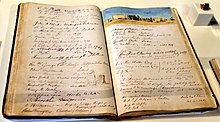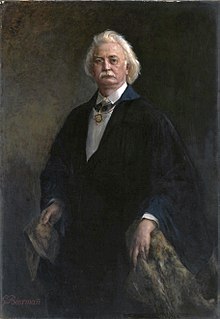Karl Richard Lepsius
This article has multiple issues. Please help improve it or discuss these issues on the talk page. (Learn how and when to remove these template messages)
|
Karl Richard Lepsius | |
|---|---|
University of Berlin | |
| Known for | Denkmäler aus Ägypten und Äthiopien |
| Spouse |
Elisabeth Klein (m. 1846) |
| Children | 6 |
| Relatives | Bernhard Klein (father-in-law) |
| Awards | Royal Gold Medal |
| Scientific career | |
| Fields | Egyptology |
| Institutions | University of Berlin |
| Signature | |
 | |
Karl Richard Lepsius (
He is widely known for his opus magnum Denkmäler aus Ägypten und Äthiopien.
Early life
Karl Richard Lepsius was the son of Karl Peter Lepsius, a classical scholar from Naumburg, and his wife Friederike (née Gläser), who was the daughter of composer Carl Ludwig Traugott Gläser.[2] The family name was originally "Leps" and had been Latinized to "Lepsius" by Karl's paternal great-grandfather Peter Christoph Lepsius.[3] He was born in Naumburg on the Saale, Saxony.[4]
He studied Greek and Roman
Work


After the death of Champollion, Lepsius made a systematic study of the French scholar's
Denkmäler
In 1842, Lepsius was commissioned (at the recommendation of the minister of instruction, Johann Eichhorn, and the scientists

Working south, stopping for extended periods at important Middle Egyptian sites, such as
Lepsius reached as far south as
In 1845, he was elected as a member to the American Philosophical Society.[9]
The chief result of this expedition was the publication of
Later career
Upon his return to Europe in 1845, he married Elisabeth Klein in 1846 and was appointed as a professor of Egyptology at Berlin University in the same year, and the co-director of the
Lepsius was president of the
Lepsius published widely in the field of Egyptology, and is considered the father of this modern scientific discipline, assuming a role that Champollion might have achieved, had he not died so young. Much of his work is fundamental to the field. Indeed, Lepsius even coined the phrase Totenbuch ("
Family
On 5 July 1846, he married Elisabeth Klein, (1828–1899), daughter of the composer
Major works

- 1842. Das Todtenbuch der Ägypter nach dem hieroglyphischen Papyrus in Turin mit einem Vorworte zum ersten Male herausgegeben. Leipzig: Georg Wigand. (Reprinted Osnabrück: Otto Zeller Verlag, 1969)
- 1849. OCLC 857205)
- 1852. Briefe aus Aegypten, Aethiopien und der Halbinsel des Sinai geschrieben in den Jahren 1842–1845 während der auf Befehl Sr. Majestät des Königs Friedrich Wilhelm IV von Preußen ausgeführten wissenschaftlichen Expedition. Berlin: Verlag von Wilhelm Hertz (Bessersche Buchhandlung). Translated into English 1853 Discoveries in Egypt, Ethiopia and the Peninsula of Sinai. London: Richard Bentley. (Reissued by ISBN 978-1-108-01711-4)
- 1855. Das allgemeine linguistische Alphabet. Grundsätze der Übertragung fremder Schriftsysteme und bisher noch ungeschriebener Sprachen in europäische Buchstaben. Berlin: Verlag von Wilhelm Hertz (Bessersche Buchhandlung)
- 1856. Über die XXII. ägyptische Königsdynastie nebst einigen Bemerkungen zu der XXVI. und andern Dynastieen des neuen Reichs. Berlin: Gedruckt in der Druckerei der königl. Akademie der Wissenschaften Internet Archive. Translated into English 1858: The XXII Egyptian Royal Dynasty, with some remarks on the XXIV and other Dynasties of the New Kingdom. London: John Murray (Republished by ISBN 978-1-108-01739-8)
- 1860. The Gospel of Mark in the Fiadidja dialect of Nubian also called the Nobiin language. Published in Berlin in 1860. Then edited by Leo Reinisch, and republished by the British and Foreign Bible Society in 1885.
- 1863. Standard Alphabet for Reducing Unwritten Languages and Foreign Graphic Systems to a Uniform Orthography in European Letters, 2nd edition, London/Berlin. (Republished by doi:10.1075/acil.5)
- 1880. Nubische Grammatik mit einer Einleitung über die Völker und Sprachen Afrika's. Berlin: Verlag von Wilhelm Hertz
Death
He had stomach ulcers which became cancerous. After five weeks of eating little, he died at 9 am on 10 July 1884.[11]
See also
- Lepsius list of pyramids
- Standard Alphabet by Lepsius
- Wilhelm Heinrich Immanuel Bleek
References
- Citations
- ISBN 978-1-317-30747-1.
- ^ Lepsius 1854, pp. 9–10.
- ^ Lepsius 1854, p. 9.
- ^ Lepsius 1993, p. 316.
- ^ a b Peck 2001, p. 289.
- ^ Orcutt, Larry (2002). "GP Hieroglyphics". Retrieved 18 February 2005.
- ^ Clammer 2005, pp. 128–31.
- ^ Lepsius, Richard (1853). Letters from Egypt, Ethiopia, and the Peninsula of Sinai. H.G. Bohn. pp. 176–180.
- ^ "APS Member History". search.amphilsoc.org. Retrieved 2021-04-12.
- ^ "Denkmaeler aus Aegypten und Aethiopien". library.si.edu. 2015. Retrieved 2021-06-29.
- ^ Ebers 1887, p. 280-81.
Sources
- Clammer (2005). Sudan. ISBN 978-1-84162-114-2.
- Ebers, Georg (1887). Richard Lepsius; a biography. Translated by Underhill, Zoe Dana. New York: William S. Gottsberger.
- Lepsius, Karl Peter (1854). Kleine Schriften: Beiträge zur thüringisch-sächsischen Geschichte und deutschen Kunst- und Alterthumskunde (in German). Vol. 1st Vol. R. Kretschmann. Magdeburg: Albert Schulz.
- Lepsius, Mario Rainer (1993). Demokratie in Deutschland : soziologisch-historische Konstellationsanalysen : ausgewählte Aufsätze. Vol. 100. Göttingen: Vandenhoeck & Ruprecht. ISBN 3-525-35763-X.
- Peck, William H. (2001). "Lepsius, Karl Richard". In ISBN 978-0-19-510234-5.
Further reading
- Wilkinson, Toby (2020). A World Beneath the Sands: Adventurers and Archaeologists in the Golden Age of Egyptology (Hardbook). London: Picador. ISBN 978-1-5098-5870-5.
External links
- Works by or about Karl Richard Lepsius at Internet Archive
- Chisholm, Hugh, ed. (1911). . Encyclopædia Britannica. Vol. 16 (11th ed.). Cambridge University Press. p. 481.
- Lepsius Archiv Archived 2011-07-18 at the Wayback Machine: archival material from Lepsius' 1842–1845 expedition to Egypt and Nubia
- Lepsius Project: Denkmäler aus Aegypten und Aethiopien: Lepsius' 12 volume masterwork on the inscriptions of ancient Egypt and Nubia; still useful today
